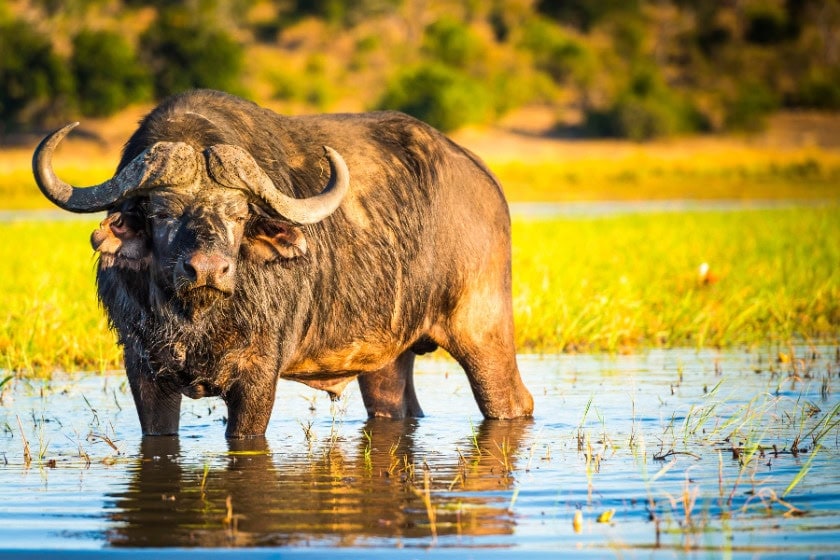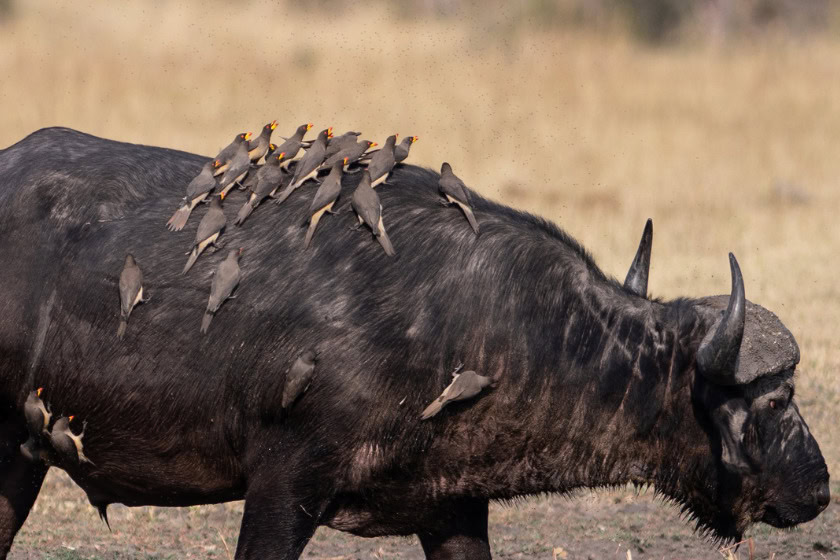If you’ve ever seen a photo of an African buffalo, chances are you’ve also seen an oxpecker. This adorable dynamic duo has long fascinated zoologists and wildlife lovers alike, and when you see them for yourself, you’ll realise that these two species have a remarkable synergy.
These small birds feed almost exclusively on what they find on the backs of the buffaloes. However, while you might think that the oxpeckers are doing the buffaloes a favour, there seems to be no real link between oxpeckers and reduced numbers of parasites on these walking buffets.
For many years, researchers believed it was a “mutualistic” relationship, with both animals deriving a net benefit from the association. However, research suggests that the red-billed oxpecker is something of a vampire, instead!
Despite the grizzly details of this unusual relationship, oxpeckers and buffaloes remain one of the cutest wildlife pairs in the world. Let’s take a closer look at how these two creatures on opposite ends of the size spectrum coexist in the African wilderness.
Meet the Red-Billed Oxpecker and the African Buffalo
You’ve probably heard of the African or Cape buffalo before. After all, it’s one of Africa’s Big Five – historically the five most dangerous wild animals to hunt on foot. Today, they’re symbols of the African wilderness, drawing countless visitors from across the globe to the continent’s safari hotspots.
Meanwhile, the red-billed oxpecker is far less conspicuous, despite its brightly-coloured beak and eyes. Let’s get to know these two animals a bit better.
African Buffalo

The African buffalo (Syncerus caffer) is a large, powerful herbivore indigenous to the African continent. It’s known for its resilience and strong social structure and can be found in a range of habitats, from savannahs and grasslands to dense forests.
There are four subspecies, with the Cape buffalo being the most well-known and widespread. African buffaloes can weigh up to 900 kg, with males typically being larger than females. They are characterised by their muscular build, large heads, and distinctively curved horns.
African buffaloes are highly social animals, living in large herds that can number in the hundreds, particularly during the rainy season when resources are abundant. These herds offer protection against predators such as lions, with the group exhibiting cooperative behaviour, especially when calves are present.
When threatened, buffaloes can be fiercely defensive, using their strong horns to charge at predators. Their unpredictable nature and strength have earned them a reputation as one of the most dangerous animals in Africa. Remember this when you go on safari! African buffaloes are not to be trifled with. Watch out for “dagga boys” in particular – these roaming groups of bachelors are considered more dangerous than other buffaloes.
In terms of diet, African buffaloes are grazers, feeding primarily on grass, but they can adapt to their environment and consume shrubs and other vegetation when necessary. Water is an essential part of their daily routine, and they are often found near rivers, lakes, and waterholes.
Despite their robust appearance, buffaloes are vulnerable to diseases like bovine tuberculosis, which has affected populations in certain regions. However, they remain a key species within Africa’s ecosystems, playing a crucial role in maintaining the balance of their natural habitats.
Red-Billed Oxpecker

The red-billed oxpecker (Buphagus erythrorynchus) is a small, yet distinctive bird native to sub-Saharan Africa. As its name suggests, it’s easily recognised by its bright red bill, yellow eyes, and brownish plumage.
Red-billed oxpeckers are well known for their coexistence with large mammals like buffaloes, rhinos, and giraffes, on which they perch to feed. Red-billed oxpeckers primarily consume ticks, dead skin, and other parasites, which they remove from the hides of their hosts. Although their feeding helps reduce the parasite load on large mammals, their role is not entirely beneficial – but more on this later.
These birds are usually seen in pairs or small groups, clinging onto their hosts using their sharp claws and short, strong legs, perfectly adapted for gripping fur. They typically nest in tree cavities, laying between two to five eggs, and their populations are stable across much of their range, though habitat loss and changes in the availability of large mammals pose potential threats in some areas.
How do Buffaloes Help Oxpeckers?
Oxpeckers feed on external parasites like ticks and flies that infest buffaloes. Consuming these parasites helps keep buffaloes’ fur and skin healthier and cleaner.
Furthermore, a buffalo’s back is often the safest and warmest place to be for these little birds. Birds of prey are less likely to attack them if their big bodyguard is around, and they also get a great vantage point to keep an eye out for potential dangers. But brace yourself – things aren’t always as they seem.
Do Buffaloes Benefit at All?

The African buffalo’s interaction with oxpeckers remains one of the most fascinating African bush interactions that still baffles scientists to this day. But is it symbiotic, or is there something more sinister going on? Let’s explore.
Oxpeckers are vigilant and have keen eyesight, allowing them to act as early warning systems for buffaloes and other prey animals. They give alarm calls whenever they sense danger from approaching predators.
By eating parasites, oxpeckers help reduce infestations. They also continuously peck at the open sores and wounds of buffaloes, cleaning them and ridding them of possible infections. Theoretically, this might aid the health and well-being of buffaloes. However, it’s not all rainbows and sunshine.
Research suggests that just like ticks and fleas, oxpeckers are also parasites. They keep fresh wounds open to feed off buffaloes’ blood, and worse still, they’ve been observed reopening old wounds! Vampire bats? More like vampire birds. Ultimately, this means that this isn’t a form of mutualism at all. Yes, the buffalo gets some benefit, but experts suggest that oxpeckers probably eat ticks and other parasites after they’ve already fed on the buffalo. And, because oxpeckers drink buffalo blood, they might be doing more harm than good.
From the outside, buffaloes and oxpeckers look like a match made in heaven. However, as with many animal relationships in Africa, the truth is far darker. Despite its size advantage, the buffalo is the loser in this situation, while the oxpecker is a true master of exploitation.
If you’re as fascinated as we are by this wildlife pair, check out our wildlife page, where you can learn more about the animals you’ll see on safari in Africa. It’s one of the best ways to get inspired for an unforgettable luxury safari experience. And, once the bug – or oxpecker – has bitten, speak to us to plan your bespoke itinerary from start to finish.
Author: Matthys Van Aswegen
Published:
Last Update: